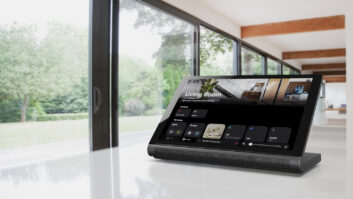Arlington, VA–The Consumer Electronics Association’s R7 Home Networking Standards Committee has approved CEA-2027 for publication.
This standard details mechanisms to allow audio/video (A/V) devices connected via a home network to present a status and control user interface (UI) on a network-attached rendering device, such as a digital television. CEA-2027 uses Web browser-based communications, including Hyper Text Transfer Protocol (HTTP) commands, to provide access and control of networked components through the main TV screen from a single remote control.
The standard specifies a method for encapsulating UI data using web and Internet protocols and contains provisions for transfer of device control screens to a TV or other digital rendering device. This is the initial release of the standard is for DTV-Link on an IEEE-1394 connection–also known as Firewire or iLink–but work has already begun on an addition to the standard to add an Ethernet connection.
“CEA is proud to be on the forefront of the HDTV transition by standardizing on technologies that will provide seamless communications of HDTVs connected to home networks and the Internet,” explained Gary Shapiro, president and CEO of the CEA. “This standard will help ensure that TVs in the future continue to add value to consumers’ viewing experience beyond simply displaying a picture, and that TVs remain the intelligent point of control for home entertainment.”
Interoperability through standardized communications between devices in the home is essential for mass-market adoption of home networks. Internet Protocols (IP) have emerged as a unifying and nearly ubiquitous way to connect CE devices to home networks because personal computers and related devices already support IP.
Unlike most previous home networking standards, this standard supports full control of any networked device, including all of its unique functions defined by the device manufacturer. This allows device manufacturers to continue to add differentiating features to their products that can be extended across the home network.
“Some product manufacturers have been reluctant to add networking connectivity to their products due to concerns about losing their brand identity,” said Bill Rose, R7 Home Networking Standards Committee chair. “This standard allows the look and feel of the overall UI, as well as the navigation between control screens, to be determined by the TV manufacturer. CEA-2027 also allows connected devices to present their manufacturer logo and retain their full set of controllable features as well.”
“CEA-2027 provides easy solutions to some previously unsolved problems in Consumer Electronics Engineering, ” said Jack Chaney, director, DMS Lab, Samsung Information Systems America. “This UI standards allows the entire multi-vendor A/V Home Network to be controlled by a single remote control. It allows features and hardware to be added externally to a device on the network and operate transparently as if they were internally integrated parts of the device.”
This standard also addresses two critical needs in home networking technologies; connecting CE and IT devices together and connecting devices in a way that allows manufacturers to preserve their brand identity. The use of Internet and web protocols is a key feature and a definite trend in communications for home networks.
Additional information can be found at www.ce.org/standards.







